By Angela Hepworth, Commercial Director at Drax
In their Sixth Assessment Report, the Intergovernmental Panel on Climate Change has clearly stated that to limit warming to 1.5C we will need carbon dioxide removals (CDRs) on a gigaton scale. The magnitude of this challenge lays starkly before us, but in equal measure with the size of the task, its importance has never been more evident.
It’s long been accepted that the world must decarbonise by reducing emissions, but the necessity of carbon removals is more newly recognised. CDRs are now acknowledged to be a crucial part of the effort to achieve net zero emissions, both to neutralise hard-to-abate emissions and sectors (like mining, transportation and aviation) and to remove excess historic carbon, or overshoot, already in the atmosphere.
At Drax we are developing Bioenergy with Carbon Capture and Storage (BECCS), which is unique in its ability to deliver renewable power and remove carbon from the atmosphere simultaneously.
Engineered carbon removal technologies like BECCS are crucial to achieving long-term climate goals. BECCS is the most scalable of these technologies that can be deployed rapidly and is affordable compared with other permanent removal solutions.
Credibility, transparency and trust
Historically, the voluntary carbon market has struggled with demonstrating credibility, transparency and trust and this has proven to be a significant weight on the industry’s ability to scale. We have seen reports of low-quality offsets sold as high integrity credits and projects that don’t deliver the carbon benefits claimed, which has diminished investor trust in the market as a whole.
To address these concerns, we are now seeing significant initiatives being put in place to implement the high standards and good governance in carbon removals credits that we need to effectively scale the market to levels required. The Integrity Council for the Voluntary Carbon Markets (ICVCM) is a prime example of this, serving as an independent governance body for the voluntary carbon market.
The ICVCM is working to champion standards across the industry and has set out its Core Carbon Principles (CCPs) – set of principles that all carbon offsets and removals must meet in order to be considered high integrity.
We welcome this initiative and hope it will raise standards across the market.
Similar to what we are seeing in the AI industry at present, in order to build trust in this nascent market and in turn scale it, it is also imperative that industry looks outside of itself and engages with other stakeholders who are impacted or interested in it. We must; develop ethical principles and guidelines for the design, development and deployment of carbon markets; implement transparent and accountable mechanisms for the oversight and governance of them; educate and engage the public and stakeholders on the benefits of CDRs; empower and protect the customers; and foster collaboration and dialogue among the industry, academia, civil society and policymakers.
Why we need standards for BECCS
At Drax we already recognise that addressing quality concerns is the only way that the market will work for everybody – buyers rightly want to have confidence that they are buying a high-integrity removals which are robustly quantified and verified, sellers need to be able to demonstrate the validity of their claims, and government needs a well-functioning market and a baseline from which to regulate it.
Our partnership with Stockholm Exergi and EcoEngineers is doing just that – developing a world-leading methodology to ensure the integrity of BECCS CDRs. The methodology was created to align with the ICVCM’s CCPs and to closely consider how to ensure everyone around the table is getting what they need:
- Quantification: For the methodology to be successful it requires a thorough approach to quantifying net-negative carbon removals from BECCS. Quantification in the methodology starts with the gross volume of CO2 we capture and store, then subtracts any supply chain emissions, and/or emissions associated with the carbon capture and storage process, as well as any “leakage” impacts (increases in CO2 emissions outside the project boundary). We have intentionally developed this approach to be both robust and conservative so that BECCS CDRs verified under the methodology are a truly net negative product.
- Guardrails: It is also crucial in any methodology for BECCS that there are robust guardrails in place to ensure biomass used comes from sustainable sources – for example, from forests where the carbon stock is stable or increasing, and excluding biomass sourced from sensitive areas where there’s high levels of biodiversity. Our methodology also provides that any potential social or environmental risks must be evaluated and mitigated for biomass to be used.
- Verification: We aim to register our credits with one of the major registries, and once a methodology is adopted, we will ensure that our credits are independently verified to confirm that they meet all the requirements set out in the standard, and that there is robust governance in place, for example to ensure credits cannot be double counted.
Taking the methodology forward
Pioneering this work for BECCS standards is an important step toward increasing investment in BECCS CDRs – a climate critical technology – and it needs to be done collaboratively. It has been developed in partnership with Stockholm Exergy and EcoEngineers and we are now working to gather feedback from other stakeholders with the aim of making it comprehensive and representative.
As a part of this we’d like to invite further feedback – from other developers, standards bodies, potential customers and others, and welcome constructive comment on the text.
The methodology has also been submitted to the European Commission to help shape their proposals for the framework for CDRs that they are developing.
It is in the interest of all parties to work towards common standards for CDRs, to avoid current fragmentation of standards that causes confusion for customers, and we appreciate your feedback on this important work as we drive it forward.
Capturing the opportunity
We have an opportunity to change our current climate trajectory, but that will only happen if we take action now. We to need to reduce emissions and rapidly scale the market for high integrity, sustainable CDRs. Putting the required standards and governance into place to build a resilient and trustworthy carbon removals market is a core part of that.
We hope that this methodology has a part to play in that work and that it will bring us one step closer to manifesting the potential of BECCS done well at scale.
Read the Methodology
Read the Executive Summary
Methodology Enquiries
To discuss or provide feedback on the Methodology please contact [email protected].





















